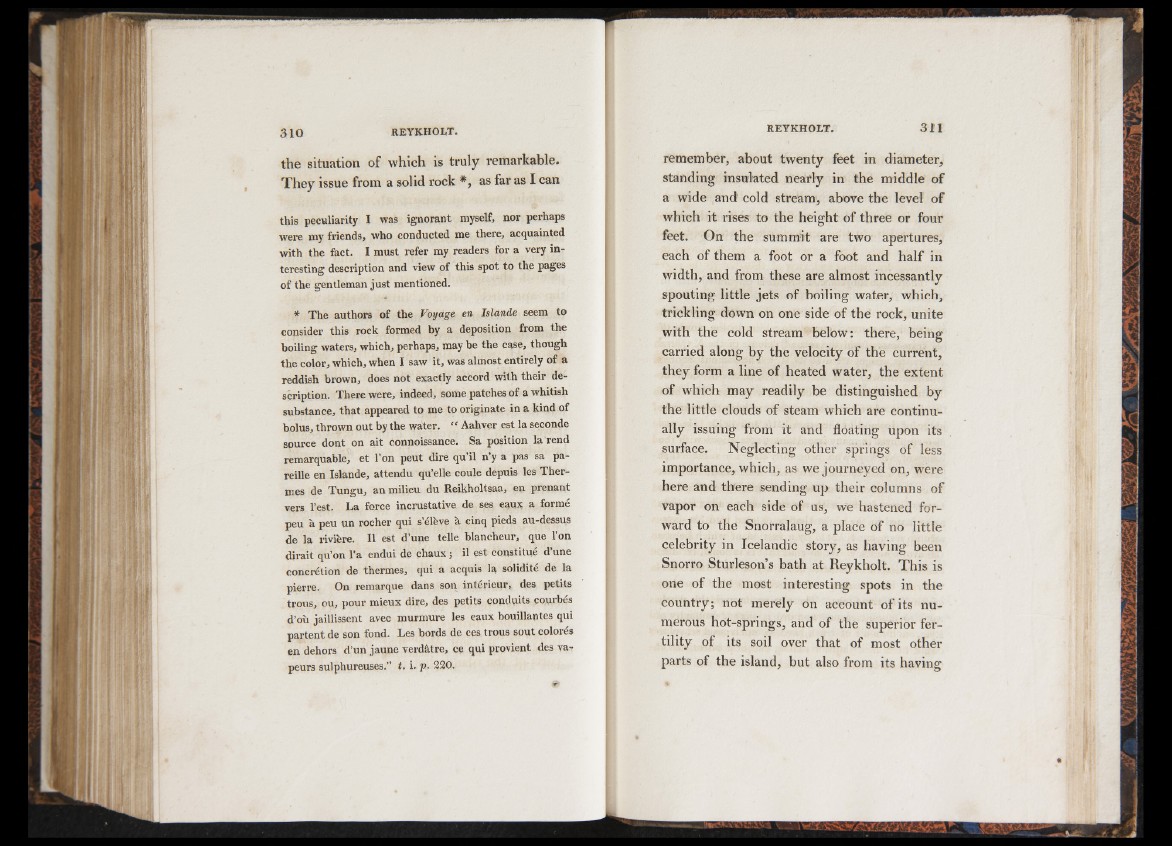
the situation of which is truly remarkable.
They issue from a solid rock #, as far as I can
this peculiarity I was ignorant myself, nor perhaps
were my friends, who conducted me there, acquainted
with the fact. I must refer my readers for a very interesting
description and view of this spot to the pages
of the gentleman just mentioned.
* The authors of the Voyage en Islande seem to
consider this rock formed by a deposition from the
boiling waters, which, perhaps, may be the case, though
the color, which, when I saw it, was almost entirely of a
reddish brown, does not exactly accord with their description.
There were, indeed, some patches of a whitish
substance, that appeared to me to originate in a kind of
bolus, thrown out by the water. “ Aahver est la seconde
source dont on ait connoissance. Sa position la rend
remarquable, et l’on peut dire qu’il n’y a pas sa pareille
en Islande, attendu qu’elle coule depuis les Thermes
de Tungu, an milieu du Reikholtsaa, en prenant
vers l’est. La force incrustative de ses eaux a formé
peu à peu un rocher qui s’élève à cinq pieds au-dessus
de la rivière. Il est d’une telle blancheur, que 1 on
dirait qu’on l’a endui de chaux ; il est constitué d’une
concrétion de thermes, qui a acquis la solidité de la
pierre. On remarque dans son intérieur, des petits
trous, ou, pour mieux dire, des petits conduits courbés
d’où jaillissent avec murmure les eaux bouillantes qui
partent de son fond. Les bords de ces trous sout colorés
en dehors d’un jaune verdâtre, ce qui provient des va-r
peurs sulphureuses.” t. i. p. 220.
remember, about twenty feet in diameter,
standing insulated nearly in the middle of
a wide and cold stream* above the level of
which it rises to the height of three or four
feet. On the summit are two apertures,
each of them a foot or a foot and half in
width, and from these are almost incessantly
spouting little jets of boiling water, which,
trickling down on one side of the rock, unite
with the cold stream belbW: there, being
carried along by the velocity of the current,
they form a line of heated water, the extent
of which may readily be distinguished by
the little clouds of steam which are continually
issuing from it and floating upon its
surface. Neglecting other springs of less
importance, which, as we journeyed on, were
here and there sending up their columns of
vapor on each side of us, we hastened forward
to the Snorralaug, a place of no little
celebrity in Icelandic story, as having been
Snorro Sturleson’s bath at Reykholt. This is
one of the most interesting spots in the
country; not merely on aceount of its numerous
hot-springs, and of the superior fertility
of its soil over that of most other
parts of the island, but also from its having